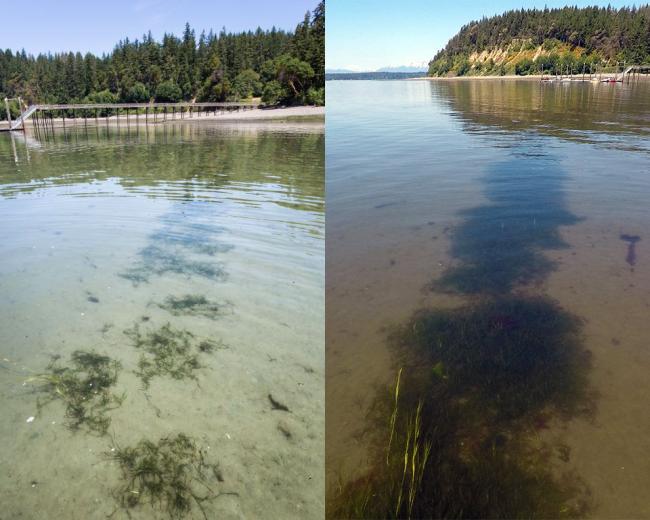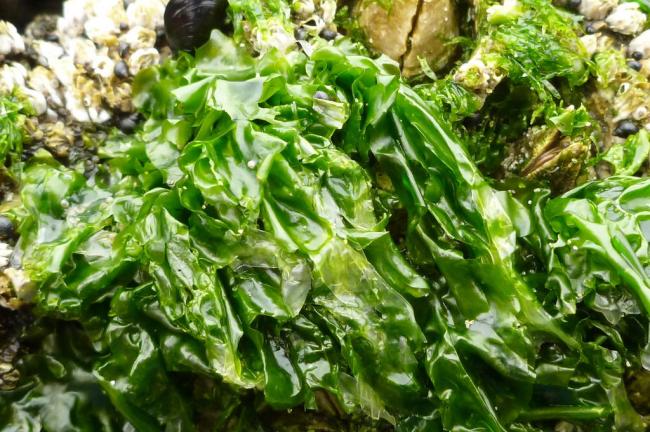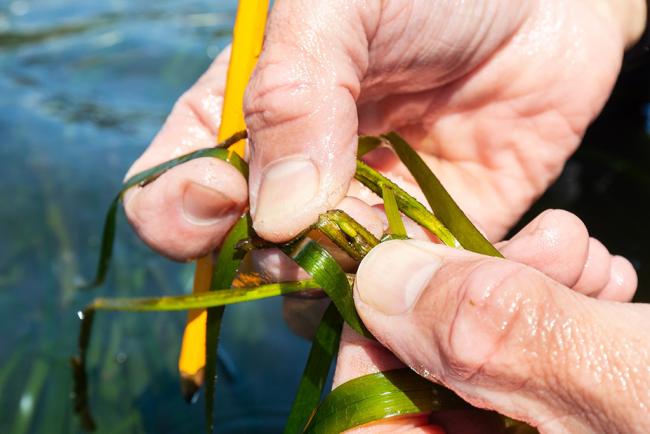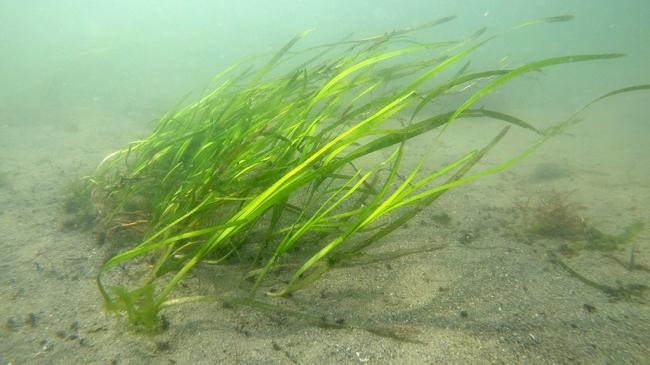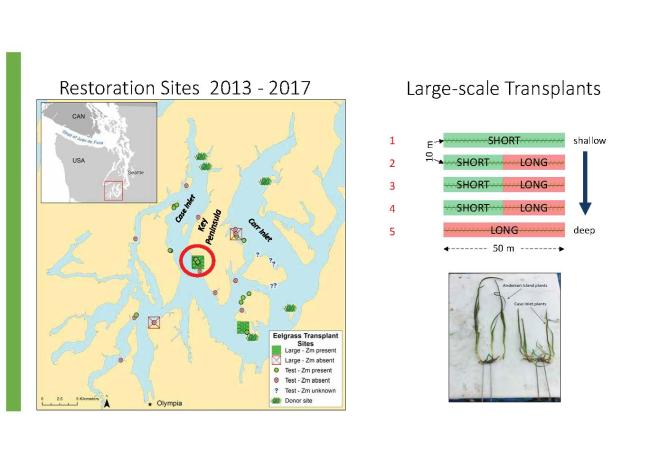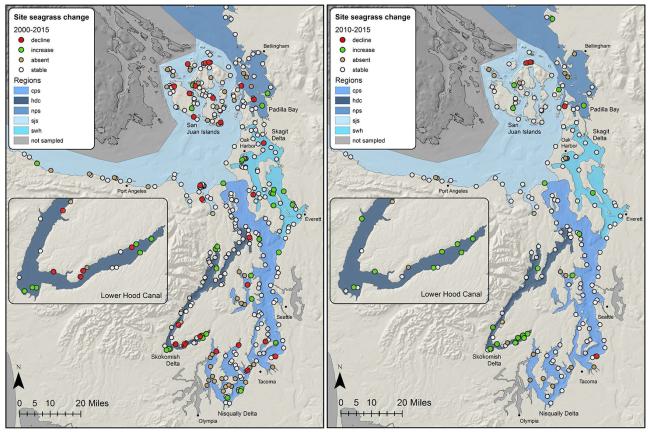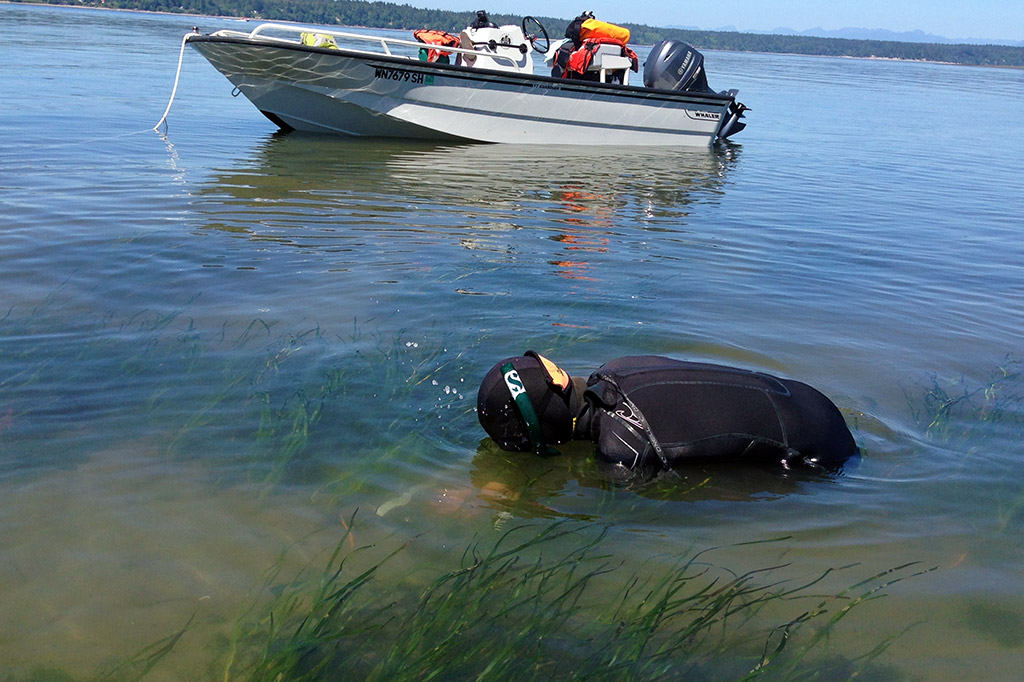
As critically important eelgrass declines in some parts of Puget Sound, scientists are trying to plant more of it. The health of the ecosystem may be riding on their efforts, but what they are finding is something that farmers have known for thousands of years: Getting something to grow may be harder than you think.

Wearing a full wetsuit and breathing through a snorkel, Jeff Gaeckle inches his way along the sandy bottom in shallow water near Joemma Beach State Park on Case Inlet. Long blades of eelgrass swirl about his face as he quickly counts the grassy shoots emerging from the sand and then measures the lengths of the dark-green blades.
As he passes through, Gaeckle, an ecologist with the Washington Department of Natural Resources (DNR) views the eelgrass bed with a scientist’s eye, but also with a certain satisfaction that a gardener or farmer might feel as a crop comes in. The eelgrass is growing.
Portions of Joemma Beach, situated on the west side of Pierce County's Key Peninsula in South Puget Sound, have become an outdoor laboratory for testing alternative methods of planting this underwater flowering plant. Scientists have deemed eelgrass critical to the Puget Sound ecosystem, and much is riding on the research activities at Joemma Beach along with some 80 other locations in Puget Sound where eelgrass has been planted and monitored.
Scientists throughout the world recognize eelgrass for its exceptional ecological value. Eelgrass provides food and shelter to a wide diversity of species, and it forms the base of a food web that stretches far beyond the eelgrass meadows, feeding fish, birds and marine mammals. One way to improve the overall health of Puget Sound is to increase the amount of eelgrass growing in different places, experts say. That is why the Puget Sound Partnership established a goal of increasing the total amount of eelgrass in Puget Sound by 20 percent.
Understanding the critical nature of eelgrass, Gaeckle has committed himself to figuring out why these plants no longer grow in some places where they once flourished. He embraces the search for new techniques to restore eelgrass and bring new life to bays and inlets throughout Puget Sound.
Satisfaction and disappointment
Gaeckle has experienced the satisfaction of observing the rapid growth of eelgrass at newly planted locations as well as the disappointment of seeing the plants killed by forces beyond his control.
Eelgrass is typically test-planted in small plots with equal spaces between them to create a checkerboard pattern. While returning to a planted area by boat, Gaeckle first scans the shallow water during a low tide. The looming question is whether he will see any observable changes.
“If I can see plants, I’m pretty ecstatic,” he said. “If it looks more like a patch than a checkerboard, that tells me that things are coalescing as the transplanted areas grow in size.”
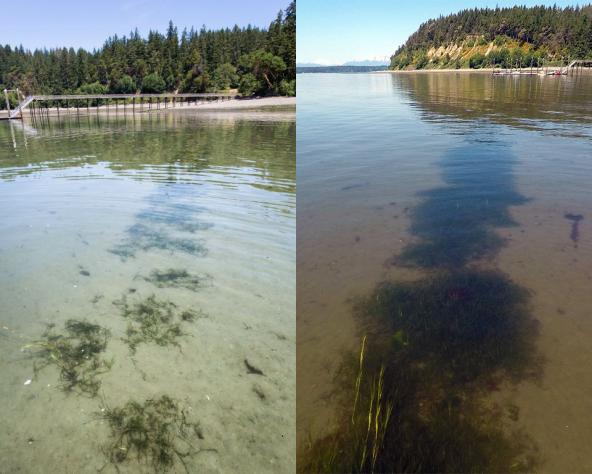
After planting a new patch of eelgrass, it may not take long for fish, crabs and shrimp to discover their new habitat, Gaeckle said. Sometimes they move in before the planting effort is complete, testifying to the high value of eelgrass.
Some crabs may damage the new transplants as they scrape tiny prey off the eelgrass blades. Snails may graze on the vegetation itself. Burrowing shrimp and other creatures often excavate under the plants, potentially dislodging them.
Gaeckle recalls feeling a wave of disappointment this past spring when he approached the northwest side of Anderson Island in South Puget Sound. From his boat, he could see that the shallow water was thick with green vegetation.
“Everything looked green,” he said, “but because of the expansiveness of it, I knew the plants were going to be gone.”
In this case, the killer of the eelgrass was sea lettuce, a macroalgae with green, leafy blades that can grow to 16 inches across. The vegetation drifts about and may get caught on the eelgrass, blocking sunlight and smothering the plants.
“The challenge with algae is the uncertainty,” Gaeckle said. “I don’t know where it is coming from. When we planted on the north side of Anderson Island, there was no algae there.”
Researchers suspect that the growth of sea lettuce and other macroalgae in Puget Sound may be stimulated by sunlight and the warmer temperatures of summer — especially in places with high concentrations of nitrogen, such as that coming from sewage-treatment plants, septic systems and fertilizers. High-nitrogen conditions may also increase the growth of phytoplankton, tiny organisms that cause problems for eelgrass by reducing the amount of sunlight that can penetrate the water.
Excessive sea lettuce has dissuaded Gaeckle and his fellow researchers from planting eelgrass in numerous bays, especially in South Puget Sound. One strategy, he said, might be to plant eelgrass in the winter and hope it gets established before the sea lettuce arrives in summer.
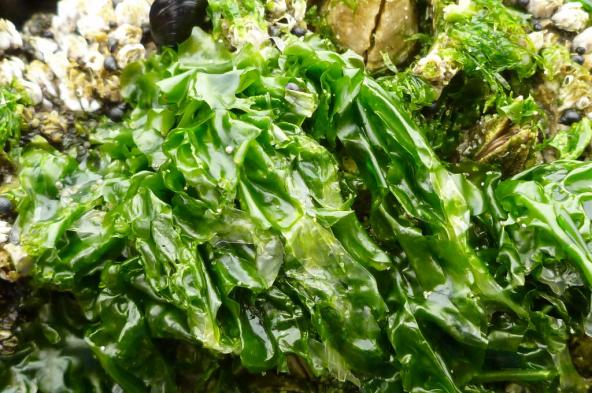
Meanwhile, the Washington Department of Ecology has launched the Puget Sound Nutrient Source Reduction Project, an effort to find ways of controlling human sources of nitrogen pouring into Puget Sound.
One question to be answered is what is the best size for a new plot of eelgrass. Small plantings may be more vulnerable to damage from sea lettuce and the creatures that wish to move in. Larger plantings mean that fewer locations can be planted with available resources.
“There is something called the mutual-protection effect,” Gaeckle said. “If you put down one or two plants, they could both be affected. If you put down 200, you could lose 75 of them, but you would still have the core of the planting.”
Growth and decline
The Department of Natural Resources has been directly monitoring the size of natural eelgrass beds for nearly 20 years. A separate study funded by the Environmental Protection Agency [Editor’s note: The study was co-authored by collaborators at the Puget Sound Institute, our parent organization] gathered historical information on herring-spawning areas — including eelgrass — to estimate changes from 1972 to 2012. During both the 20- and 40-year time frames, the total acreage in eelgrass has remained relatively stable, although some beds have declined while others have increased.
The fact that eelgrass is expanding in some areas is seen as encouraging by local scientists, given an ongoing decline of seagrasses in many places throughout the world. Although studies point to no net loss of eelgrass for Puget Sound since the 1970s, there are some indications that far more eelgrass was present during the 1800s.
“There has been a lot of work to protect water quality, starting with the Clean Water Act of 1972,” said Bart Christiaen, a scientist for DNR who leads the state’s eelgrass-monitoring program. “Also, eelgrass has been designated as a habitat of special concern by the Department of Fish and Wildlife, and is protected by several state regulations.
“The fact that eelgrass has remained stable overall indicates that these efforts have paid off, but we have long-term declines in some areas of greater Puget Sound, and that is a reason for concern.”
Of 358 sites monitored multiple times for eelgrass since 2000, no significant change in acreage was observed for 69 percent of the sites. Meanwhile, 8 percent of the sites showed increased acreage in eelgrass — equal to the percentage of sites with decreased acreage. The remainder, some 15 percent, contained no native eelgrass.
Conditions seem to be looking better since 2010. Between 2010 and 2015, about 10 percent of the sites showed short-term increases, while only 2 percent showed short-term declines. Data collected since 2015 are still being analyzed, but it appears that this trend has continued at least through 2016.
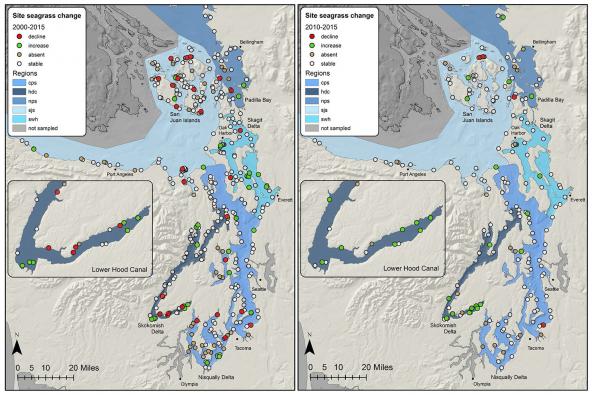
Both long-term and short-term studies show that the greatest losses take place near the heads of inlets and bays, probably related to poor water-circulation patterns, Christiaen said.
Areas with significant long-term declines include inner Case Inlet and Carr Inlet in South Puget Sound; Quartermaster Harbor in Central Puget Sound; Port Gamble Bay in northern Hood Canal; and Westcott Bay, Garrison Bay, Blind Bay, Swifts Bay and Watmough Bay, all in the San Juan Islands of North Puget Sound.
Strategic approach
In 2011, the governing board of the Puget Sound Partnership concluded that increasing the growth of eelgrass could produce a cascading effect on ecosystem recovery, encompassing a multitude of species — including Chinook salmon, which were listed as threatened under the Endangered Species Act and provide the primary food supply for the endangered killer whales.
The Leadership Council, as it is called, established an ecosystem “target” that calls for increasing the amount of eelgrass in Puget Sound by 20 percent before the year 2020. Starting with a baseline of 53,300 acres around 2008, the goal is to add 10,600 acres by 2020.
“We realized, from the time the recovery goal came out, that there was no way we could plant ourselves to that goal,” Gaeckle said. “At the cost per acre, planting 10,000 acres of eelgrass would be cost prohibitive.”
Even if one could plant 10,000 acres, there would be no guarantee that the eelgrass would survive. Studies were needed to support a strategy of planting eelgrass in places where it would take off, growing and multiplying on its own. New techniques might be needed to plant eelgrass as efficiently as possible.
A strategy to meet the goal, developed in 2015, placed the greatest emphasis on protecting existing eelgrass beds, followed by efforts to encourage their natural expansion. Such ideas include retrofitting docks to improve light penetration; installing mooring buoys to prevent damage from anchors in popular recreation areas; and taking steps to restore shorelines to more natural conditions.
As for eelgrass restoration, researchers developed a numerical model for predicting the success or failure of an eelgrass planting in a particular location. Predictions are based on the needs of eelgrass: sandy or sand-mud substrate with adequate light, along with the proper temperature and salinity. Under the right conditions, eelgrass will grow in a strip along the shoreline — no deeper than the light will adequately penetrate while not so close to shore that the plants become dried out at low tide.
The researchers working on the predictive model screened 2,630 sites in Puget Sound and identified more than 15,000 acres of suitable habitat for eelgrass — more than enough to meet the goal of expanding eelgrass beds by 20 percent.
“I think we can get there, but not by 2020,” said Ron Thom of Pacific Northwest National Laboratory in Sequim, who led the modeling effort.
Improving the survival of eelgrass plantings while expanding the growing areas could bring success in the future, provided the waters become clearer and the macroalgae blooms are reduced, Thom said. Both might be accomplished by limiting human sources of nitrogen, he said, adding that the strategy has worked in Chesapeake Bay on the East Coast and in European waterways.
Helping eelgrass get started
Eelgrass transplants generally take hold in sandy areas if their roots remain in contact with the substrate without disturbances to uproot them, Gaeckle said. Getting eelgrass to grow in barren areas — even where eelgrass has grown before — is often a challenge, because they can be uprooted by waves, burrowing shrimp or even boats passing by.
Established eelgrass beds are better able to contend with disturbances, remaining anchored with the help of a thick growth of rhizomes extending through the sediment and sending up new shoots. Established beds can soften the wave impact and even collect drifting sediment to clear the water and help hold the plants in place.
Four planting techniques are under active review to determine the best way to give individual plants a good start:
The jury is still out on which planting method to use under various conditions, Gaeckle said. Weighing preparation time against the degree of success is expected to provide guidance for future planting efforts throughout Puget Sound.
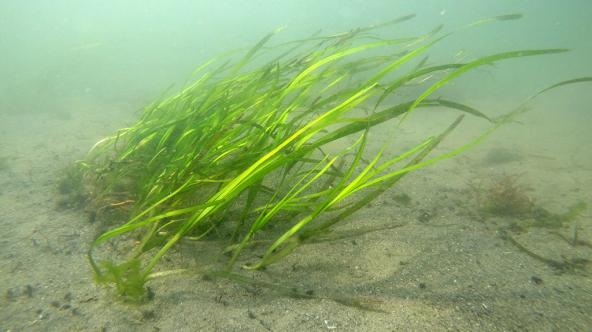
One important discovery is that eelgrass transplants may take time to get established before they begin to expand. At Joemma Beach, 22,000 eelgrass shoots were planted over 3,000 square feet in 2015. By 2016, the number of shoots and planted area had dropped to roughly half that much. By 2017, however, the number of shoots had grown to nearly five times the number planted in 2015, and the vegetated growing area was more than 20 percent greater.
Some plants are bound to be lost from the mere act of transplanting, Gaeckle said. The survivors must find a way to overcome ongoing challenges at a given site. But once established, the tendency is for the rhizomes to spread into barren areas while new shoots increase the overall density.
A continuing issue is where to obtain eelgrass for transplanting into new locations. The traditional choice has been to take donor stock from established eelgrass beds located as close to the transplant bed as possible. Plants are selected from throughout the donor bed, and the slight thinning is believed to cause minimal harm to the established eelgrass. But is this the best way?
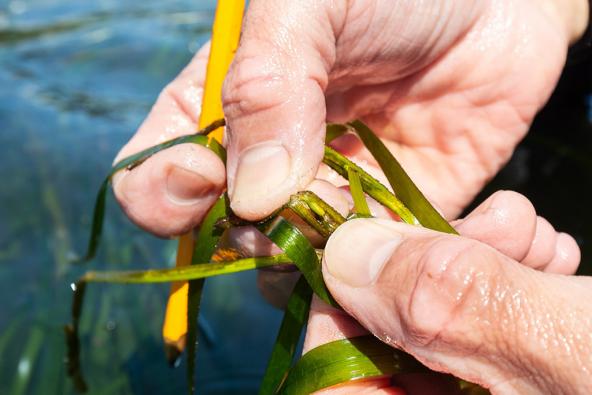
From a genetics standpoint, questions remain about how well eelgrass has become adapted to particular conditions, such as the type of substrate, the temperature and the amount of wave energy they must endure. Researchers wonder if eelgrass in North Puget Sound is closely related to eelgrass in South Puget Sound or if they have evolved somewhat independently.
New genetic studies are getting underway with the help of University of Washington researchers along with scientists from the DNR, Gaeckle said.
In addition to studying the genetic makeup of eelgrass throughout Puget Sound, Gaeckle is planning an experiment in which eelgrass from one established bed is transplanted to another established bed where conditions are demonstrably different. Plants from the second bed are then transplanted to the first. The goal is to see if one can identify eelgrass populations that are more tolerant of specific conditions and to see if those differences can be detected by genetic analysis.
Understanding genetic differences among various eelgrass populations could improve the selection of eelgrass used in transplantation and increase the growth of eelgrass meadows throughout Puget Sound.


